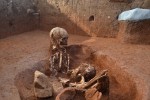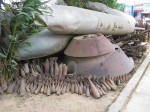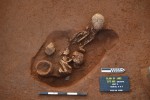 Archaeologists have unearthed a burial ground at one of Laos’ most fascinating and mysterious ancient sites, the Plain of Jars. The remains are estimated to be about 2,500 years old. An international team of archaeologists from The Australian National University (ANU), Monash University and the archaeology division of the Lao Ministry of Information, Culture and Tourism discovered seven burials and four probable burials with ceramic grave goods.
Archaeologists have unearthed a burial ground at one of Laos’ most fascinating and mysterious ancient sites, the Plain of Jars. The remains are estimated to be about 2,500 years old. An international team of archaeologists from The Australian National University (ANU), Monash University and the archaeology division of the Lao Ministry of Information, Culture and Tourism discovered seven burials and four probable burials with ceramic grave goods.
 The Plain of Jars is a group of more than 90 megalithic sites in the central Lao province of Xieng Khouang which are peppered with monumental stone jars carved from a quarry five to six miles away and then dragged to the various jar groupings. This was an impressive feat as some of the jars are massive; the largest weigh 10 metric tons. Most of them are made of sandstone, but four other rock types — granite, conglomerate, limestone and breccia — were also used. They range from three to 10 feet high, two to six-and-a-half feet in diameter and are basically cylindrical in shape although they funnel upwards a little with a wider bottom than top. Rims around the top suggest they used to have lids, but no lids have ever been discovered in situ. Other stone pieces have been found, however: discs placed on the ground over burial pits and unworked stone grave markers.
The Plain of Jars is a group of more than 90 megalithic sites in the central Lao province of Xieng Khouang which are peppered with monumental stone jars carved from a quarry five to six miles away and then dragged to the various jar groupings. This was an impressive feat as some of the jars are massive; the largest weigh 10 metric tons. Most of them are made of sandstone, but four other rock types — granite, conglomerate, limestone and breccia — were also used. They range from three to 10 feet high, two to six-and-a-half feet in diameter and are basically cylindrical in shape although they funnel upwards a little with a wider bottom than top. Rims around the top suggest they used to have lids, but no lids have ever been discovered in situ. Other stone pieces have been found, however: discs placed on the ground over burial pits and unworked stone grave markers.
 Each jar grouping contains between one and 392 jars, the latter of which is near a Hmong village that can only be accessed by foot. The group where the burial ground was recently discovered is called Site 1 and has more than 300 jars, stone discs and grave markers. Very little is known about the makers of the Plain of Jars megaliths. With no writing and few engravings on the stones, archaeologists haven’t had much to go on.
Each jar grouping contains between one and 392 jars, the latter of which is near a Hmong village that can only be accessed by foot. The group where the burial ground was recently discovered is called Site 1 and has more than 300 jars, stone discs and grave markers. Very little is known about the makers of the Plain of Jars megaliths. With no writing and few engravings on the stones, archaeologists haven’t had much to go on.
 In the first excavations in the 1930s, archaeologists found evidence of cremation, including burned teeth and bone fragments, inside the jars. They also found unburned human skeletal remains buried around the jars along with pottery, iron and bronze objects, beads and other artifacts. After that, there was a gap of six decades before the next archaeological explorations of the site. For almost a decade (1964-1973), the Plain of Jars was pelted with an unspeakable number of bombs by the US in the Secret War against the North Vietnamese and Pathet Lao communists. US planes dropped 262 million cluster bombs on Laos, almost all of them on the Plain of Jars, and 80 million of them never exploded. Many of the ancient stones suffered irreparable damage, and the unexploded ordnance made one of the most important prehistoric sites in the world so dangerous that archaeologists didn’t return until 1994, and even though they stuck to surveys and a handful of excavations then they were taking enormous risks.
In the first excavations in the 1930s, archaeologists found evidence of cremation, including burned teeth and bone fragments, inside the jars. They also found unburned human skeletal remains buried around the jars along with pottery, iron and bronze objects, beads and other artifacts. After that, there was a gap of six decades before the next archaeological explorations of the site. For almost a decade (1964-1973), the Plain of Jars was pelted with an unspeakable number of bombs by the US in the Secret War against the North Vietnamese and Pathet Lao communists. US planes dropped 262 million cluster bombs on Laos, almost all of them on the Plain of Jars, and 80 million of them never exploded. Many of the ancient stones suffered irreparable damage, and the unexploded ordnance made one of the most important prehistoric sites in the world so dangerous that archaeologists didn’t return until 1994, and even though they stuck to surveys and a handful of excavations then they were taking enormous risks.
UNESCO and the Mines Advisory Group NGO cleared seven of the jar sites between 2004 and 2007, one of which was Site 1. This opened the door for a major archaeological excavation that might answer some of the many questions about who made these jars and why.
 One popular theory was that the jars were used as vessels for decomposing bodies. Once the soft tissues had decayed, the bones were then buried around the jars. This year’s discovery of primary burial where the individual was interred in the burial ground and never moved is therefore of great importance.
One popular theory was that the jars were used as vessels for decomposing bodies. Once the soft tissues had decayed, the bones were then buried around the jars. This year’s discovery of primary burial where the individual was interred in the burial ground and never moved is therefore of great importance.
[The Australian National University archaeologist and dig leader] Dr O’Reilly said the dig had revealed three distinct types of burial.
“There are pits full of bones with a large limestone block placed over them and other burials where bones have been placed in ceramic vessels,” he said. “Our excavations have also revealed, for the first time at one of these sites, a primary burial, where a body was placed in a grave.”
He also said that determining the status of the buried individuals was difficult due to a lack of material objects buried with them, but hoped some genetic analysis might shed some light on whom these people were related to.
DNA and stable isotope analysis could provide key information on the ethnicity and geographic origin of the people who used the stone jars. The project will continue for five years, stretching further afield to the Assam region of northeastern India where there are megalithic jar sites that are similar enough to the Laotian Plain of Jars to explore whether there may be a link between them.
never heard of those places before. Digging in Laos… Now that Whats im calling commitment to an ideal :notworthy: Please drop us a bone When the DNA’s are out. Thanks!
Fascinating! I didn’t know anything about these sites…
And yes, I agree with Jim Joel about excavating in an area full of unexploded bombs….
I suppose they will also try to determine the age of the various burials? Because the variety also kind of suggests an option not yet mentioned: That the jars were created by one group of people, who probably used them for burial purposes and centuries later, the people then living in the area buried their dead around the jars because they still associated those with the dead/ancestors/a gateway to the afterlife. A history which may have repeated itself twice.
It’s not that unlikely, just look at the use of sites with standing stones in the UK. And it would explain the markedly different funerary practices.
great blogs outstanding information…